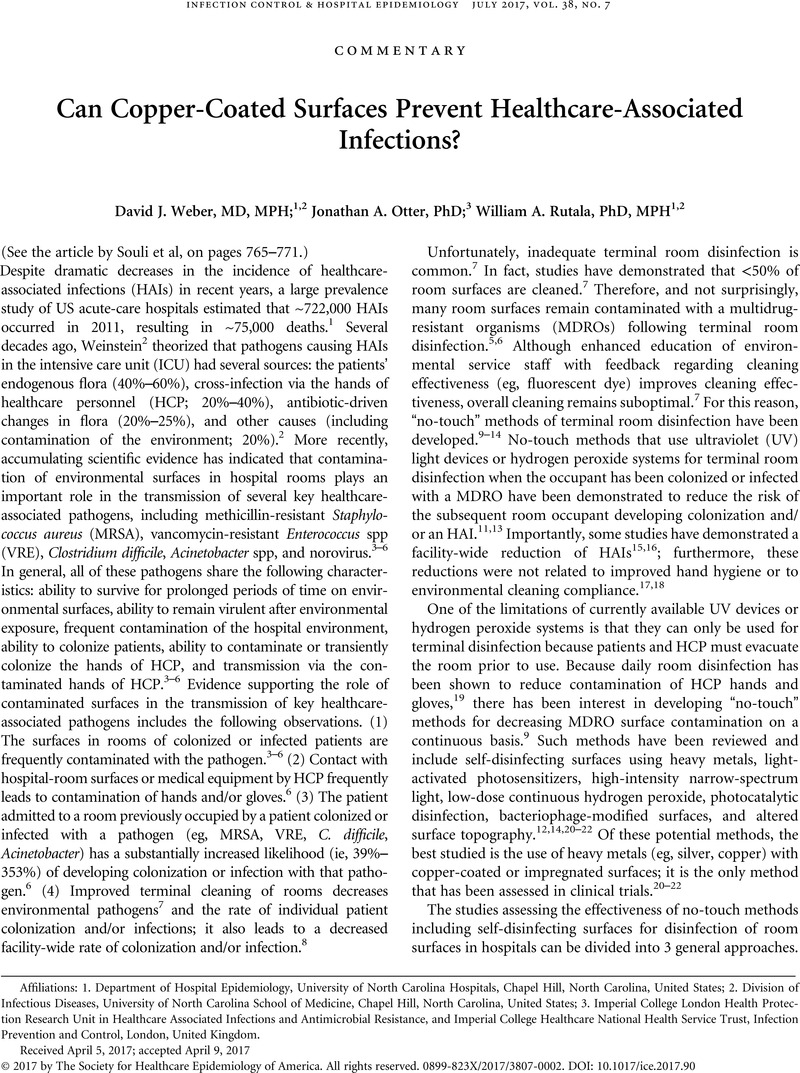Crossref Citations
This article has been cited by the following publications. This list is generated based on data provided by Crossref.
Abbas, Mohamed
Pires, Daniela
Peters, Alexandra
Morel, Chantal M
Hurst, Samia
Holmes, Alison
Saito, Hiroki
Allegranzi, Benedetta
Lucet, Jean-Christophe
Zingg, Walter
Harbarth, Stephan
and
Pittet, Didier
2018.
Conflicts of interest in infection prevention and control research: no smoke without fire. A narrative review.
Intensive Care Medicine,
Vol. 44,
Issue. 10,
p.
1679.
Montero, David A.
Arellano, Carolina
Pardo, Mirka
Vera, Rosa
Gálvez, Ricardo
Cifuentes, Marcela
Berasain, María A.
Gómez, Marisol
Ramírez, Claudio
and
Vidal, Roberto M.
2019.
Antimicrobial properties of a novel copper-based composite coating with potential for use in healthcare facilities.
Antimicrobial Resistance & Infection Control,
Vol. 8,
Issue. 1,
Weber, David J.
Rutala, William A.
Sickbert-Bennett, Emily E.
Kanamori, Hajime
and
Anderson, Deverick
2019.
Continuous room decontamination technologies.
American Journal of Infection Control,
Vol. 47,
Issue. ,
p.
A72.
Wright, Bradley W.
Kamath, Karthik S.
Krisp, Christoph
and
Molloy, Mark P.
2019.
Proteome profiling of Pseudomonas aeruginosa PAO1 identifies novel responders to copper stress.
BMC Microbiology,
Vol. 19,
Issue. 1,
Salonen, Noora
Mäkinen, Riika
Ahonen, Merja
Mäkitalo, Tiina
Pelto-Huikko, Aino
and
Latva, Martti
2022.
A comprehensive indoor hygiene concept for infection prevention and control within built environments.
Frontiers in Built Environment,
Vol. 8,
Issue. ,
Weber, David J.
Rutala, William A.
Anderson, Deverick J.
and
Sickbert-Bennett, Emily E.
2023.
..úNo touch..Ñ methods for health care room disinfection: Focus on clinical trials.
American Journal of Infection Control,
Vol. 51,
Issue. 11,
p.
A134.
Andrews, Daniel J.
Eddy, Timothy L.
Hollenback, Kelsey S.
Sreekumar, Shravan
Loose, Davis C.
Pennetti, Cody A.
Polmateer, Thomas L.
Haug, James C.
Oliver‐Clark, Lessie I.
Williams, Joi Y.
Manasco, Mark C.
Smith, Steven
and
Lambert, James H.
2023.
Enterprise risk management for automation in correctional facilities with pandemic and other stressors.
Risk Analysis,
Vol. 43,
Issue. 4,
p.
820.



